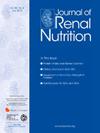维持性血液透析患者营养风险指数与感染相关住院及住院后死亡的关系。
IF 3.2
3区 医学
Q2 NUTRITION & DIETETICS
引用次数: 0
摘要
目的:透析患者经常因心血管疾病(CVD)和感染而住院。这一人群再次住院和随后死亡的风险也很高。除了严重的后果外,住院还会产生大量的医疗费用。因此,预防住院迫在眉睫。在此,我们研究了营养失调是否与住院及随后的死亡有关:研究采用前瞻性设计,使用日本透析结果和实践模式研究(J-DOPPS)的数据。暴露指数为日本血液透析营养风险指数(NRI-JH),通过该指数将患者分为低、中、高风险组,低风险组为参照组。主要结果是心血管疾病相关或感染相关的住院治疗。次要结果为全因死亡率。在探索性分析中,研究了住院前的基线或最近一次 NRI-JH 与住院后死亡的关系:在中位随访 2.6 年期间,4021 名患者中有 566 人因心血管疾病住院,375 人因感染住院。在多变量 Cox 模型中,基线时的 NRI-JH 与感染相关的住院治疗显著相关,但与心血管疾病相关的住院治疗无关(危险比 [HR] 1.46,95% 置信区间 [CI]:1.09 至 1.97,1.09 至 1.97):中风险组与低风险组相比,危险比为 1.09 至 1.97,p = 0.012)(高风险组与低风险组相比,危险比为 2.46,95% 置信区间 [CI]:1.81 至 3.35,p < 0.001)。NRI-JH 还与全因死亡率相关。此外,基线组和最新的高风险 NRI-JH 组与心血管疾病相关住院和感染相关住院后的死亡显著相关:结论:通过 NRI-JH 评估的较高营养风险与感染相关的住院治疗有关,但与心血管疾病相关的住院治疗无关。然而,NRI-JH与心血管疾病相关住院和感染相关住院后的死亡都有显著相关性,这表明营养风险可能与住院或随后的死亡单独相关。NRI-JH可能有助于规划个人护理以改善预后。本文章由计算机程序翻译,如有差异,请以英文原文为准。
Association of Nutritional Risk Index With Infection-Related Hospitalization and Death After Hospitalization in Patients Undergoing Maintenance Hemodialysis
Objective
Patients undergoing dialysis frequently experience hospitalization due to cardiovascular disease (CVD) and infection. This population is also at high risk of rehospitalization and subsequent death. In addition to serious outcomes, hospitalization incurs substantial medical cost. Prevention of hospitalization is accordingly an urgent matter. Here, we examined whether nutritional disorder was associated with hospitalization and subsequent death.
Methods
The study was conducted under a prospective design using data from the Japanese Dialysis Outcomes and Practice Pattern Study. The exposure was the Nutritional Risk Index for Japanese Hemodialysis (NRI-JH), through which patients were divided into low-, medium-, and high-risk groups, with the low-risk group as referent. The primary outcome was CVD-related or infection-related hospitalization. Secondary outcome was all-cause mortality. For exploratory analyses, the associations of baseline or latest NRI-JH just before hospitalization, with death after hospitalizations, were examined.
Results
Of 4021 patients, 566 patients had CVD-related hospitalization and 375 had infection-related hospitalization during a median follow-up of 2.6 years. NRI-JH at baseline was significantly associated with infection-related hospitalization but not with CVD-related hospitalization, in multivariable Cox models (hazard ratio [HR] 1.46, 95% confidential interval [CI]: 1.09 to 1.97, P = .012 for medium-risk vs. low-risk group) (HR 2.46, 95% CI: 1.81 to 3.35, P < .001 for high-risk vs. low-risk group). NRI-JH was also associated with all-cause mortality. In addition, the baseline and latest high-risk NRI-JH groups were significantly associated with death after both CVD-related and infection-related hospitalizations.
Conclusions
A higher nutritional risk as evaluated by NRI-JH was associated with infection-related hospitalization but not with CVD-related hospitalization. However, NRI-JH was significantly associated with death after both CVD-related and infection-related hospitalizations, suggesting that nutritional risk may be separately involved in hospitalization or subsequent death. NRI-JH may be useful in the planning of individual care to improve outcomes.
求助全文
通过发布文献求助,成功后即可免费获取论文全文。
去求助
来源期刊

Journal of Renal Nutrition
医学-泌尿学与肾脏学
CiteScore
5.70
自引率
12.50%
发文量
146
审稿时长
6.7 weeks
期刊介绍:
The Journal of Renal Nutrition is devoted exclusively to renal nutrition science and renal dietetics. Its content is appropriate for nutritionists, physicians and researchers working in nephrology. Each issue contains a state-of-the-art review, original research, articles on the clinical management and education of patients, a current literature review, and nutritional analysis of food products that have clinical relevance.
 求助内容:
求助内容: 应助结果提醒方式:
应助结果提醒方式:


